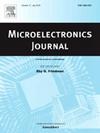An adaptive background light rejection technique with integrated laser interference filter for direct time-of-flight sensors
IF 1.9
3区 工程技术
Q3 ENGINEERING, ELECTRICAL & ELECTRONIC
引用次数: 0
Abstract
To suppress the varying background light and laser interference in direct time-of-flight (DToF) sensors, this paper presents an adaptive pixel-to-pixel coincidence detection and smart time gating technique. Each pixel contains one single-photon avalanche diode and shares signals with surrounding pixels. The coincidence detection level is automatically adjusted based on the coincidence of the signal and noise. Time gating is generated based on the output of a time-to-digital converter. The technique is implemented through circuit design using a 110 nm process and validated through behavioral modeling and circuit simulations. Simulation results show the technique achieves success rates (SRs) exceeding 60% and signal-to-noise ratios (SNRs) above 3 under background light levels ranging from 10 to 100 klux. It maintains SRs exceeding 50% and SNRs above 2 for target distances ranging from 0.5 to 46.5 m. It ensures signal-to-interference ratios above 1 under laser interference. This technique enables DToF sensors to operate under varying background light levels and effectively filters out laser interference.
用于直接飞行时间传感器的集成激光干扰滤波器自适应背景光抑制技术
为了抑制直接飞行时间(dof)传感器中背景光和激光的干扰,提出了一种自适应像素间符合检测和智能时间门控技术。每个像素包含一个单光子雪崩二极管,并与周围像素共享信号。根据信号与噪声的符合程度自动调整符合检测级别。时间门控是基于时间-数字转换器的输出产生的。该技术通过使用110纳米工艺的电路设计实现,并通过行为建模和电路仿真进行验证。仿真结果表明,在10 ~ 100 klux的背景光照下,该技术的成功率超过60%,信噪比超过3。在0.5至46.5米的目标距离内,信噪比维持在50%以上,信噪比维持在2以上。保证在激光干扰下信干涉比大于1。该技术使dof传感器能够在不同的背景光水平下工作,并有效滤除激光干扰。
本文章由计算机程序翻译,如有差异,请以英文原文为准。
求助全文
约1分钟内获得全文
求助全文
来源期刊

Microelectronics Journal
工程技术-工程:电子与电气
CiteScore
4.00
自引率
27.30%
发文量
222
审稿时长
43 days
期刊介绍:
Published since 1969, the Microelectronics Journal is an international forum for the dissemination of research and applications of microelectronic systems, circuits, and emerging technologies. Papers published in the Microelectronics Journal have undergone peer review to ensure originality, relevance, and timeliness. The journal thus provides a worldwide, regular, and comprehensive update on microelectronic circuits and systems.
The Microelectronics Journal invites papers describing significant research and applications in all of the areas listed below. Comprehensive review/survey papers covering recent developments will also be considered. The Microelectronics Journal covers circuits and systems. This topic includes but is not limited to: Analog, digital, mixed, and RF circuits and related design methodologies; Logic, architectural, and system level synthesis; Testing, design for testability, built-in self-test; Area, power, and thermal analysis and design; Mixed-domain simulation and design; Embedded systems; Non-von Neumann computing and related technologies and circuits; Design and test of high complexity systems integration; SoC, NoC, SIP, and NIP design and test; 3-D integration design and analysis; Emerging device technologies and circuits, such as FinFETs, SETs, spintronics, SFQ, MTJ, etc.
Application aspects such as signal and image processing including circuits for cryptography, sensors, and actuators including sensor networks, reliability and quality issues, and economic models are also welcome.
 求助内容:
求助内容: 应助结果提醒方式:
应助结果提醒方式:


